The AER’s paper
The AER recently published a detailed consultation paper proposing rule changes for semi-scheduled generation in response to a request from the COAG Energy Council – you can see a brief overview on WattClarity. I don’t agree with the scale of changes proposed by the AER, but I do think the regulatory bodies need to work with the industry to make some specific regulatory tweaks and operational improvements to keep the semi-scheduled category workable for now, leaving changes of the scale proposed here by the AER for a well-considered market redesign in NEM 2.0.
I’ll start with a comment on process. The AER is consulting on this rule change at the request of the COAG Energy Council – “That semi-scheduled generators be obligated to follow their dispatch targets in a similar manner to scheduled generators.” This sounds like a solution rather than a problem, and in starting with the solution it doesn’t give the AEMC scope to consider all options in making a rule that best supports the National Electricity Objective – to be in the “long-term interests of consumers”. It’s important to understand what the problem is, before rushing to a solution. In this article, I’ll look at what I think the specific problems are, identify significant issues in the AER’s analysis and the proposed solutions, and suggest potential alternatives.
Problems
Working through the AER’s issues paper two key problems stand out that need to be addressed, which in the paper are not always clearly separated. The first problem is a market issue, where semi-scheduled generators can currently choose to curtail their output below their dispatch level for non-physical reasons. The issues paper also relates this behaviour to a concern about observed increasing levels of variability, but from analysing the data I see that in part there is a more complex technical issue here about how wind farms restart after reducing generation. The second key problem is a technical issue where generators, whether curtailing due to a dispatch instruction or otherwise (so not always related to the first problem), can move too quickly between output levels such that the system frequency is adversely affected.
Problem 1: The “Behaviour”
On the first key problem, the market regulatory issue, the AER’s issues paper spends much time discussing “the behaviour” – where semi-scheduled generators choose to reduce their output outside of the bid and dispatch process. Paul examined this in more detail here, explaining that this appears to be allowable under the current NER. It’s clear that it’s not sustainable to have an increasing number of generators behaving in this way. The semi-scheduled category is to deal with intermittency, not to give a blank cheque to do what you like* outside the market processes. One of the major tasks of the dispatch process is to match supply to demand, with aggregate off-target outcomes (also called the dispatch error) needing to be made up by frequency regulation services. The aggregate dispatch error due to random fluctuations of the wind or solar resources (the intermittency) across renewable generators can be studied statistically as AEMO has done in the recent Renewable Integration Study, and expectations formed on how manageable it is (including whether it is scalable in the future). It’s much harder to manage a systematic reason for dispatch error (including deliberate participant behaviour) where many sites are significantly off-target simultaneously.
*This rule change is looking only at semi-scheduled generators – but don’t forget there are also non-scheduled generators and large non-registered loads in the NEM which operate without consideration of dispatch targets. NEM 2.0 with a two-sided market promises to bring the loads into the market.
So how prevalent is this “behaviour”? Figure 4 and 5 and the accompanying text in the paper suggests that it’s rapidly increasing. I did my own analysis of the period Jan 2017 – Apr 2020 and arrived at a different conclusion. It’s not possible from the publicly available data to determine exactly what’s going on, but looking carefully at patterns in the data plus some knowledge of how wind farms operate gives a different plausible explanation, suggesting there may be some technology-specific issues that would be beneficial to address.
Source: Issues paper – Semi scheduled generator rule change(s), AER, June 2020
I reconstructed the data in figure 4 above, which looks just at negative-priced dispatch intervals, counting those where output was below target by more than 20 MW. I examined in detail many of the dispatch intervals included in the analysis, finding that at least 40% of the time, most likely a lot more, the off-target is for a different reason. The data doesn’t clearly show an increase in the “behaviour” over time (though it does appear to be what happened in some intervals), but does indicate other drivers of below-target outcomes that may be worth addressing:
- an increase in the number of large farms (including large solar farms) where a 20 MW deviation due to forecasting error is not uncommon (during middle-range winds for a wind farm, or a partly-cloudy day for a solar farm), and just happens to occur at the same time as a negative price, accounting for at least 10% by my count, probably more;
- an increase in the response (through bids) of wind farms to negative prices, meaning more intervals where wind farms came slowly back up from zero (more on this in a minute), which by my count accounts for at least 30% of the intervals;
- a few hours (accounting for many intervals) that appear to be due to high-wind cut-out or other weather-specific forecasting issues, where several farms are together significantly off-target for an hour or more;
- a few hours (again, accounting for many intervals) where it looks like a plant issue that was not adequately communicated to AEMO, where output is stuck either at zero or an unusual figure (such as 5 MW or 35 MW) for an extended period, apparently uncorrelated with price.
Whether these have a system impact or not will depend on how correlated they are across farms. A 20 MW deviation by one farm is unlikely to disturb the power system or market, while a number of farms under-target simultaneously could be a problem.
- The first point above, random forecasting error, is likely to typically occur in a diversified manner (notwithstanding extreme and/or unlucky events, such as investigated here by Paul), and so a raw count of plant off-target by 20 MW doesn’t give a measure of the system impact.
- The second (slow ramping up) may typically occur at around the same time across sites if dispatch targets are moving around with negative price periods. I look at this further below.
- The third (high-wind cut-out and other weather-specific forecast issues) may typically occur at the same time across sites due to the weather patterns, compounding the system impact. High-wind cut-out was somewhat addressed in the Energy Conversion Model Guidelines consultation in 2016, and the advances in Participant Forecasting will continue to improve this.
- The fourth (plant issues) should be easy enough to fix by appropriate systems and processes on the participant side (including the Local Limit SCADA signal added to the Energy Conversion Model in 2016), and which would be even easier if participants could directly enter a reduced availability in their bid.
A complex technical issue: Wind farm ramping
In my analysis of the data in the AER’s figure 4 (above) I identified a technical issue as the potential source of a large number of the off-target events, which was also mentioned briefly by a market participant in the discussion at the AER’s recent forum on the paper. The issue is that many wind farm technologies recover slowly from curtailment to a low output in a way that can result in below-target generation for some dispatch intervals on the way back up. Without going into specifics of each technology (I’ll leave that to the generator owners or turbine manufacturers), when a wind farm’s output is curtailed a little it will tilt the blades out of the wind (“feathering”), while when it’s curtailed a lot (the threshold varies between models) some turbines are shut down (or “paused”). Once restarted by the wind farm controller (as it would typically do once the curtailment is lifted), the turbines may take several minutes to restart, with the full output arriving too late for the current dispatch interval but ready for the next. As discussed in some detail in the submissions and meeting minutes of AEMO’s Energy Conversion Model Guidelines consultation in 2016, particularly on page 2 of this document here, a low forecast (and therefore a low dispatch target) could be generated for that interval, but this may result in a wind farm getting locked into low production as it never gets a high enough target to restart the turbines.
Here’s an example using the Unit Dashboard widget in ez2view from a recently-built wind farm (noting that I don’t know if they had an operator deliberately holding the farm back, but it looks unlikely as it then went to full power then next dispatch interval). The 11:15 dispatch target (like the 11:10) was 0 MW and the farm had ramped down (the black line is the output, while the coloured bars indicate the bids, and the faint grey line is the target). The 11:20 dispatch instruction had no semi-dispatch cap and a level of 56 MW, but the farm achieved only 7 MW, getting back up to 50 MW in the next dispatch interval.
Here’s a further example from an older wind farm. In the 14:00 dispatch interval the target was 0 MW (as it had been for several before). In the 14:05 interval the target lifted to 30 MW but output remained at 0 MW, lifting to 30 MW during the following interval.
I’m not going to try to provide solutions here, but suggest that it may lie somewhere between technical changes in how wind farms are controlled in this situation and regulatory changes such as enabling dispatch inflexibility profiles or similar, as done for fast-start gas plants. Either way, co-operation with industry will be key to making workable improvements in the number of off-target events.
Problem 2: Frequency swings
So that was the first issue – now for the second, which I see as distinct from the first, as it’s relevant to generators controlling their output regardless of the reason. The AER’s paper identifies the concern that wind and solar farms are ramping too fast and causing frequency swings, and proposes as a solution that linear ramps are required from semi-scheduled generators at all times. I’ll look more at the proposed solution below, but here in the “problems” section, it’s important to understand what the problem is, so that the solution does not demand excessively expensive compliance for little additional benefit. All generation technologies (in particular large mechanical systems such as wind turbines) have technical limitations on their ability to ramp smoothly, particularly when there is little headroom in the resource. Is the problem that anything off a linear ramp at any time is a system security risk, especially considering the damping that will come from the primary frequency response (PFR) improvements? Or is the problem the very short-timeframe changes? Understanding this better may help develop and implement a more proportionate solution.
Proposed solutions
The AER’s paper works through a number of solutions, arriving at two options. Option 2, to abolish the semi-scheduled category altogether, seems excessive and would come at massive cost to the renewable generation industry (and therefore in time, consumers), so I won’t look at it further. Option 1 proposes that semi-scheduled plant operate on a linear ramp from one dispatch interval to the next, effectively applying the existing “semi-dispatch cap” to all intervals, not just those where excess production is a market or system security problem. In the case where the resource (wind or sun) drops off, it’d be acceptable for the output to drop below the target.
I can see a number of issues with this solution, around the introduction of a one-sided intermittency problem, the material lost-revenue cost, and the impact on (and misplaced faith in) forecasting.
One-sided intermittency problem
The proposed solution appears to introduce its own system security problem in requiring intermittent generators to ramp to a target in every dispatch interval. A wind or solar farm is able to control its output down to a target if the resource is there, but isn’t able to control up to a target if the resource has fallen. This means that the aggregate dispatch error (and therefore the demand on frequency regulation services) would lose the current benefit of the netting out of random over- and under-generation across intermittent generators. Instead, the over-generation is discarded and all the under-generation would be summed. This would mean an increase in the magnitude of the aggregate dispatch error (biased strongly to under-generation), and I expect making a re-run of the Renewable Integration Study results significantly more concerning. This appears to be a fundamental problem with this proposed solution.
Lost revenue
The issues paper considers that the lost-revenue cost to generators is expected to be low. I’ve done the numbers on this – it’s not massive, but it’s certainly not little, and there’s a further consideration on the reduced forecasting accuracy in this scenario. The diagram below shows the calculation, applied only the intervals without a semi-dispatch cap, as the semi-dispatch cap already limits the output. Assuming (and this is a big assumption, which I’ll come back to) that the forecast availability under the proposed change is the same as it is now, we can look at what actually happened in reality – either generation above or below the dispatch level, shown as A or B here – to see what energy would be lost if the generator was required to limit its output to the dispatch level. There’s only lost revenue in the case where the generator performed above the dispatch level (i.e. at A here).
Calculating this over all semi-scheduled generators in the NEM between January 2017 and June 2020 gives an approximately 1.7% reduction in generated energy. Looking just at 2019, if the value of this generation to the generators is conservatively estimated at $60/MWh, this is $20m across the industry.
I said there was an assumption made here about the accuracy of the forecast and how this is different when the output is capped. The AWEFS and ASEFS forecasting systems make use of a variety of information in preparing the dispatch forecasts and prioritises some information over others. There are many factors that influence the output of a wind or solar farm, including ambient temperature, wind direction, the dynamic state of mechanical systems (turbines or solar tracking systems) and voltage effects. Notwithstanding the value added by systems that add information on imminent changes to conditions (including Lidar for wind and cloud-cams for solar), the best forecast of what will happen in 5 minutes’ time is strongly based on what the farm is generating right now, as the current output incorporates the effect of all factors.
AEMO’s AWEFS wind forecasting system includes logic to detect when the wind farm is curtailed (or “down-regulated”). When not curtailed, AWEFS uses a forecast mostly based on the measured MW output (sometimes referred to as a “persistence” forecast, though the AWEFS forecast is a little more complex), to get the most accurate result. When curtailment is detected, it uses a forecast based on measured wind speed and turbine availability, put through a power curve (a statistically-tuned mapping of wind speed to turbine output, or equivalent for solar). More details (as it was in 2016) are in this AEMO document on AWEFS. The statistically-tuned power curve is an approximation of the real world, and cannot capture all the factors currently affecting the generator, reducing its accuracy. (The Participant Forecasting program is working to improve this). Given that the output is capped at this less-accurate forecast in the AER’s proposal, the reduction in generated energy realised may be higher than as estimated above, as illustrated in the example below, comparing the lost generation due to under-forecasting for illustrative good and poor forecasts.
How to forecast?
While on the topic of generation forecasting, and greatly increasing the dependence on it, note that the current approach for most forecasting systems (AWEFS/ASEFS included, and I would assume the participant forecasting systems including those with machine learning) is to train the models based on observations of unconstrained generation (i.e. running without curtailment). This would be impossible if there weren’t any unconstrained observations to use because the generators were constraining output in every dispatch interval. Putting it simply – you can’t improve what you can’t measure. At some future time curtailment may become so frequent that new forecasting approaches become necessary, but for the near future this isn’t a reasonable proposition.
A way forward
So, where to go from here? Having identified fundamental issues with the proposed Option 1 solution, let me propose some ideas of my own.
First, let’s remember what the problems were: 1) the “behaviour” – generators choosing to curtail below the dispatch level, and 2) rapid ramping disturbing frequency. There’s also the associated issue I identified of how wind farms come up after curtailment, that may appear confused with problem 1.
Problem 1 – curtailment below the dispatch level
On problem 1, the NZ market has an example of a solution (extract below) that doesn’t require always curtailing generation. Addressing a similar issue of wind farms choosing to operate below the dispatch level (compounded in NZ by the fact that wind farms weren’t at the time able to bid other than at the floor), the Electricity Authority in NZ in 2019 implemented a change to the Code (equivalent to the NER) that specifically outlaws the behaviour of concern, in stating that the participant may only deviate more than 30 MW below the forecast for a “bona fide physical reason”, and added the requirement for participants to submit a report after each month detailing any occurrences and evidence of the bona fide physical reasons.
This would appear to give the power to the regulator (that is currently lacking) to prosecute cases of systematic deliberate curtailment with minimal other impacts on the operation of semi-scheduled generators. In addition, to assist semi-scheduled participants in maintaining compliance, it would be worth considering enabling the MAXAVAIL field in the bid file (currently overwritten by the AWEFS/ASEFS or participant dispatch forecast) to limit the dispatch availability. This would give participants a direct manual interface to manage their maximum dispatch level, if that should be necessary in the case of plant and/or forecasting system issues.
The issue I discussed earlier where some wind farms may have difficulty meeting dispatch targets when coming up from curtailment may need to be handled as these intervals could be caught up in a rule like this. It could be considered a ‘bona fide physical reason’, given the nature of the plant control systems, or a workable solution be found with industry to improve the below-target generation at these times.
Source: https://www.ea.govt.nz/code-and-compliance/the-code/
Problem 2 – managing ramping to reduce frequency swings
The AER’s proposed solution to rapid ramping applies a one-size-fits-all approach, requiring a linear ramp between dispatch levels regardless of the need for curtailment for market or system reasons. I can see two distinct cases to consider – one (where the generator is curtailing its output), where high ramp rates are a risk, and the other (where the generator is running unconstrained), where the risk is much lower.
In the case where generation is moving in or out of curtailment, so has headroom to work with to smoothly control its output, it seems reasonable and proportionate to require controlled ramping of output within the physical capability of the plant. This could be required when a semi-dispatch cap is applied and in the interval following, to catch the ramp-up phase.
During times when a semi-scheduled generator is not controlling or curtailing its output (currently, whenever there isn’t a semi-dispatch cap), rapid ramping and significant deviation from the target isn’t likely a feature of a generator’s output other than for infrequent large sudden swings in resource availability. There isn’t much that can be done (other than mandated storage) to protect against large swings down in the resource availability, but a limit of say 20% of registered capacity above the dispatch level could be applied to limit the extreme upswings.


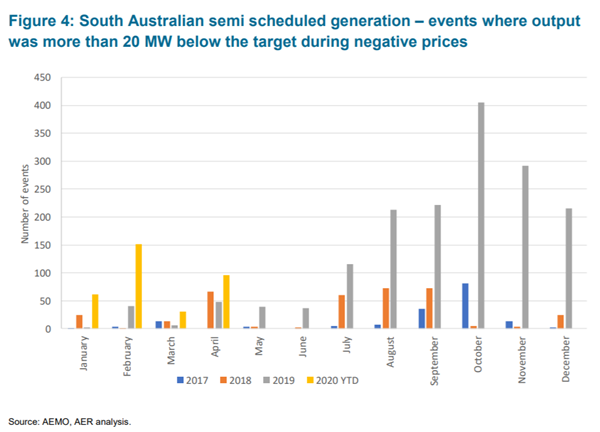
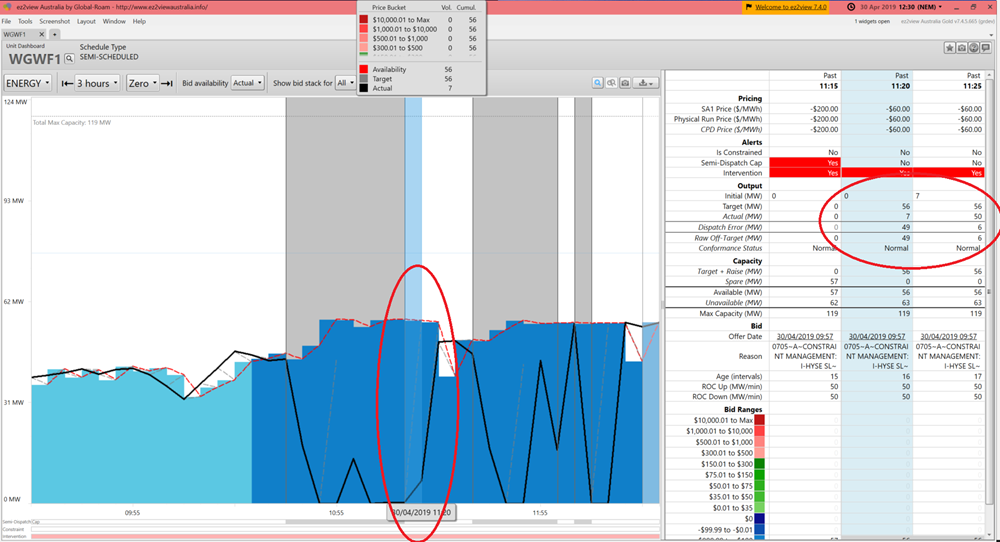
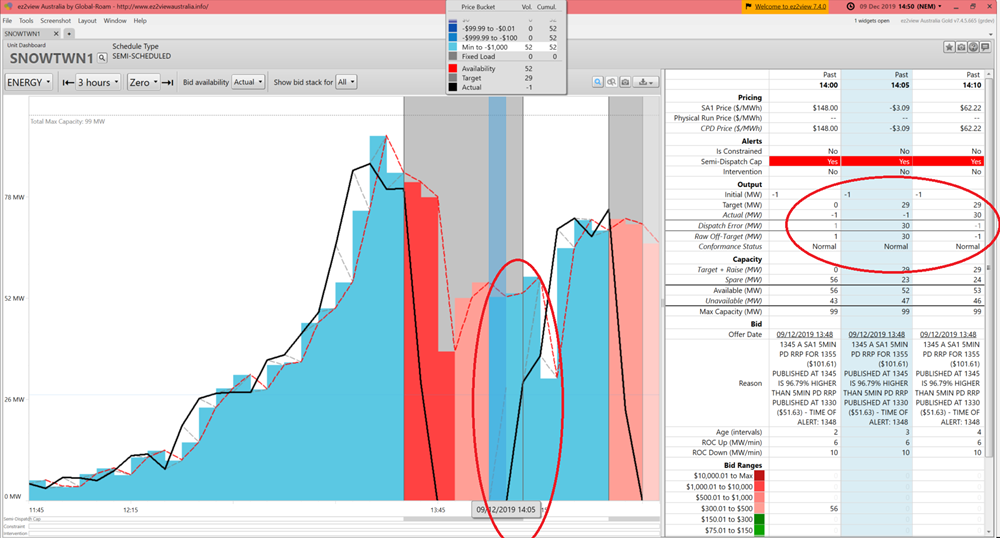
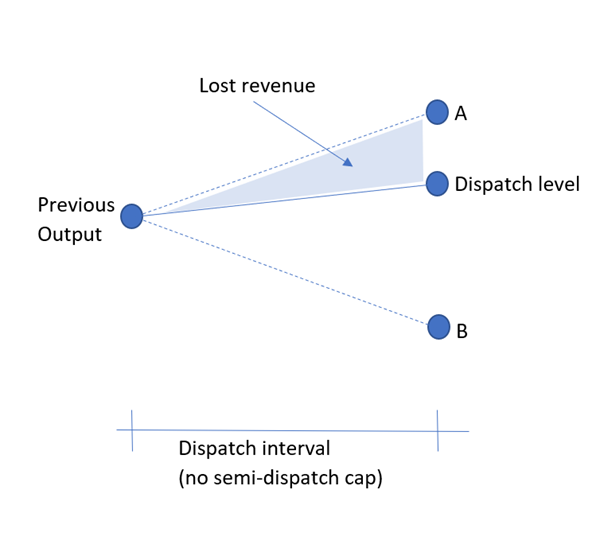
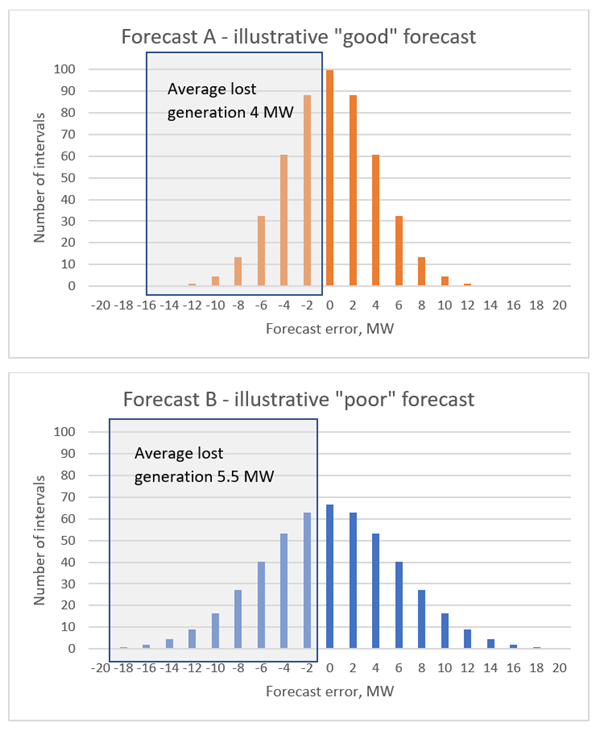
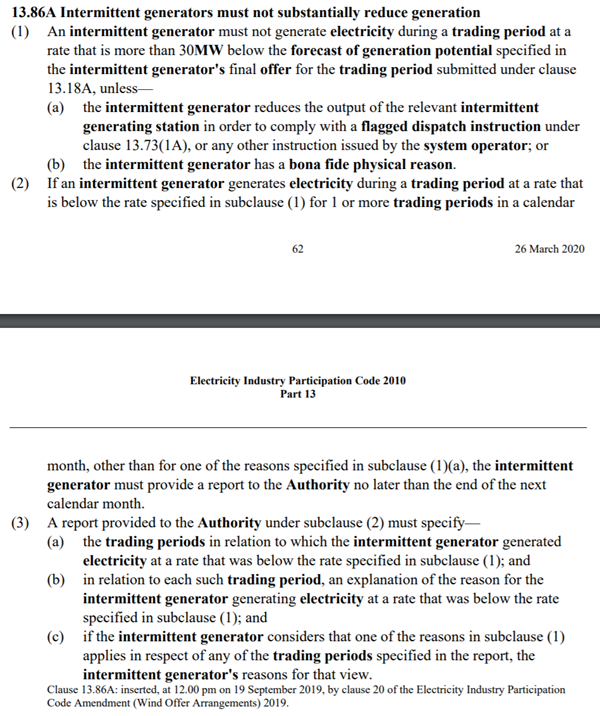
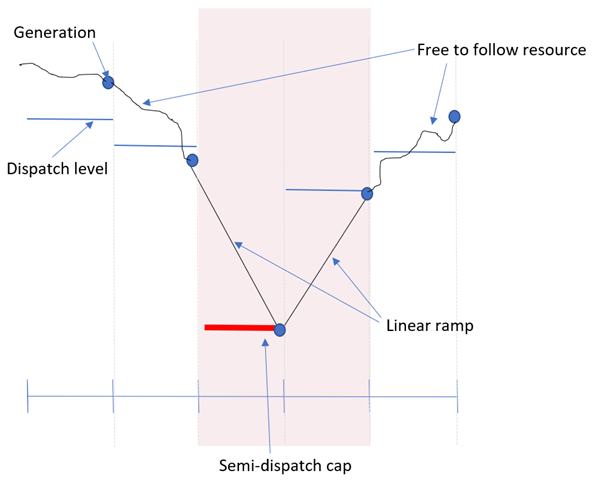
Great article. A question about your curtailment calculation, where you estimated that 1.7% of generation might be curtailed under the rule change. Was this calculated using 4s data, or just the 5-minute initial_MW and total_Cleared data? I used 4s data for several sites for a couple of different months and obtained a significantly higher curtailment estimate.
Thanks David. I used the InitialMW data shifted 5 minutes to line up with the corresponding TotalCleared (dispatch level) value. I approximated (as shown in the diagram) the curtailment as a triangle – i.e. (FinalMW – TotalCleared) / 2 * (1/12). It was far too much work to look at the 4 second data!
Thanks for the quick response. Agree it’s a lot of work, hence I’ve only done a handful of generators and a couple of months. But output can vary greatly within a 5 minute period, often ramping above the target. So I’m concerned your curtailment estimate using 5 minute data is considerably below the true value if generation has to remain below the target at any given moment. My estimates are approx 3% for wind and 5% for solar.
The only opportunity for wind and solar to put downward pressure on electricity cost is on wholesale prices during favourable weather.
Wind and solar increase the cost of all other components of the electricity chain.
The correct definition of ‘the problem’, is that there is no market for intermittent electricity. The market matches supply to demand. It does not match demand to weather.
When you phrase ‘the problem’ in these terms, it is clear that all significant generators participating in the market should be able to perform that fundamental function.
Great article Marcelle – especially the analysis refuting the AERs (or COAGs) conclusion of the SA output more than 20 MW during negative prices graph was due to deliberate of generation (it was so dodgy when I read the AER paper that instantly dismissed it but you provided some great data driven reasons), and the reference to the NZ market solution that is a possible pragmatic solution.
Sorry, but I can’t really see the problem – surely the market is simply saying causer pays. You cannot keep putting generation into a power system that cannot be relied upon to “do what it says it is going to do” once it becomes a significant share of the market. And certainly not when ancillary service markets (including LFAS) are simply not reflective of the cost of providing the service. How about instead of looking for free rides all the time that developers fix their limitations by either contracting with others to correct their market position for them, install storage to self regulate their position across trading intervals or even auxiliary generation to clean up after themselves. Yep it is going to cost some money – perhaps the immature conversation around LCOE being the sole comparative metric in the generation space might be about to change – not before time.